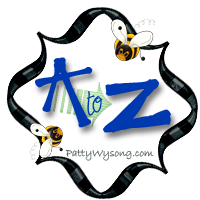 This post is part of the A to Z blog hop. Scroll to the end of this post for other blogs to visit. This week, posts are to start with the letter "A."
This post is part of the A to Z blog hop. Scroll to the end of this post for other blogs to visit. This week, posts are to start with the letter "A."
Chris Weatherhead and Clarence Felder
Bring History to Life through Film and Stage
Actress/director/playwright/producer Chris Weatherhead and her actor /director/ producer/writer husband, Clarence Felder, have a passion for breathing life into history through film and stage.
I first met Chris and Clarence in September 2009 at the SC State Museum following a viewing of their independent film,
All for Liberty, a Revolutionary War era account of a relative of Clarence’s, Henry Felder, and a militia band of South Carolina backcountry Patriots.

These two highly creative people, dressed as their movie characters, greeted me and others in the audience with a graciousness and warmth that was endearing. I knew right away that these were people who love what they do and who want to shine a light on Americans and what they accomplished during the Revolutionary War.
I met them again a year later at the dedication of Thomson Park, a memorial for the defense of Sullivan’s Island, SC.
Colonel William Danger Thompson led a motley crew of 780 patriots composed of militiamen, enlisted soldiers, Native American marksmen, and a few slaves who gallantly defended the island from a force of more than 2,900 British soldiers and loyalists. The British offense, led by Generals Clinton and Cornwallis, were stationed on Long Island (now Isle of Palms), and most of the battle took place over what is now known at Breach Inlet.
As fellow history lovers, we gravitated to each other and have been friends ever since.
All for Liberty
Clarence is a sixth generation, direct descendent of Captain Henry Felder of the Orangeburg district in SC and the first & second Provincial Congress.
After discovering this heritage, he researched and wrote the play,
Captain Felder’s Cannon, which was then used as a basis for a feature film screenplay for All for Liberty. Clarence portrays Henry Felder in the film.
All for Liberty is the previously untold account of Felder’s stance against the British Empire along with other militia leaders in the backcountry of South Carolina from 1776–1780.
The fight was instrumental in diverting British troop energies while George Washington’s army lay nearly defeated far to the North. Felder raises a militia and rallies against Tory loyalists and stall the British under General Cornwallis, giving Washington needed time to revive his forces.
Unlike the prettified versions of legend, the American Revolution was no simple chess match of bluecoats versus redcoats.
All for Liberty portrays how strife predominated between neighbors and friends, eventually destroying communities.
The story, which focuses on the price Captain Felder, his family, and community had to pay for their convictions, was shot on 31 locations in South Carolina and Georgia, using 14 historical sites, and the Felder Farm in Calhoun County. Crew included historical advisors.
Cast and crew banded together to produce the film without the backing of a large studio, in order to keep it historically correct as possible, replicating the main character’s persistence and struggle against external forces.
Producer Ron Mangravite explains, “We wanted to create this movie because it tells the story of a forgotten part of our history. These people suffered and did so much, yet they have pretty much disappeared from national memory. We walk the ground they did but rarely connect with what happened on that ground.”
Thoughts from
Director Chris Weatherhead
When I began the journey of
All for Liberty in 2004, like most Americans, I knew very little about the American War for Independence, much less what volcanic and indispensable fighting had occurred among the people who fought in the back country of South Carolina.
I wanted to bring to the screen a true story I had recently learned that enthralled me, based on a play my husband wrote about his sixth generation great-grandfather.
As a director of theater since the fourth grade, I was always a sucker for a great story and usually find the truth more compelling than fiction.
I was excited by new digital technology and had been tracking it for fifteen years before buying the camera we used to shoot this picture.
I run a theater company and for three years had been luring my staff and actors into various digital movie and theatre productions before deciding to shoot this story. It was daunting to launch into an indie historical-action-adventure of this scope, but I couldn’t stop myself.

Where were we to get period clothing? How was I going to keep the 21st century out of the frame? Where would I find soldiers and cannon?
But, since having completed the film in spite of seemingly endless difficulties, I am still in love with those wildly committed people on the colonial frontier, who were so desperate for liberty they were willing to die for it. And I continue to be captivated and inspired by what I have learned from them and those who continue to fight for freedom today.
Kudos for All for Liberty
"… …realistic action....beautifully filmed…a reminder of how easy it is for freedom to be lost… this excellent film has something for everyone."
Hugh Harrington, free-lance film critic, Georgia
“…a genuine Revolutionary War hero…Clarence Felder majestically portrays his valiant German-Swiss ancestor with charismatic chemistry…Outstanding sound by Jeffrey Stern and music by Anthony DeRitis…so authentic… captured battle scenes with perfection.”
Sandy Katz, Free-lance Entertainment Journalist
“… emotionally moving, beautifully photographed and historically accurate tribute to an unknown hero of the American Revolution."
Michael C. Scoggins, Director, Southern Revolutionary War Institute
“Based on true events...this movie will leave you feeling good about America's hard-fought war for independence. Played wonderfully by Clarence Felder, Henry Felder was Swiss...His wife is vividly and well-played by Chris Weatherhead... We award our Dove "Family-Approved" Seal to the movie for ages twelve plus.”
Edwin L. Carpenter, Dove Foundation Worldview Review
"....a rare jewel…beautifully shot feature film…a true story of inspiring adventure and unique heroism that is of universal appeal to anyone, anywhere in the world..."
Urs T. Brunner, CEO, Angel & Bear Productions, Bangkok, Thailand
Awards for All For Liberty
Recently named One of The Ten Best Revolutionary War Films
Accolade Competition, La Jolla, California:
Winner! 3 awards!
Excellence: Feature Film, Leading Actor, Clarence Felder & Sound Design.
42nd WorldFest Houston, Texas:
Winner! 3 awards!
Special
Jury Award [Theatrical Feature], Gold [Art Direction], Platinum [Feature Trailer]
Charleston International Film Festival:
Winner!
Audience Choice for Best Picture
Myrtle Beach International:
Winner!
Best Picture, faith-based Feature Film
Southern Appalachian International Film Festival:
Winner!
Best Independent feature Film,
Sons of the American Revolution, South Carolina:
Silver Citizenship Medal to Clarence Felder
Award of Appreciation,
Chris Weatherhead, Director
Daughters of the American Revolution, Lady Washington Chapter, Houston TX
Winner!
First prize in Media
DOVE Foundation - Michigan
Winner!
DOVE Foundation Family Seal of Approval for age 12+
World premiere:
Beijing International Film Festival…2009 US Movie Exchange…
Audience Comments
"The subject - Excellent depiction of lost history!"
"Everything was fantastic! Must be grateful to those who made freedom possible!
"Great story so well told -- the movie had a great flow!"
"Thank you! - Much needed movie!"
"Show this film everywhere!"
"Uplifting message"
"Please keep this going"
"Should be seen by all Americans!"
All For Liberty Endorsements from Christian viewers
"...this rare, wonderful film needs to be seen by all Christian families to know what great sacrifices were made for freedom and liberty and to create our nation..."
Norma T. Hall, former Methodist Sunday school teacher, Cuyahoga Falls, Ohio
“…dynamic portrayal of the courage, commitment, and sacrifice of our forefathers to ensure God given freedoms and values would prevail…”
Myron C. Harrington Jr., Col. USMC Ret., Vietnam Veteran
“The spirit of America lives and breathes in this captivating film…
every Christian
and patriot should see.
It brings our heritage of God and Country to the forefront where it belongs."
Reverend Chris Horne, The Christian Nation Online
“…draws us into the Revolutionary War of our forefathers and mothers who sacrificed for us….excellent, historically accurate, adventure-filled film; one the whole family can enjoy. One can only pray for more movies like it!
Susan F. Craft, author, The Chamomile, winner of the SIBA Fall 2011 Okra Pick
“This film is such a great way to remind us freedom is a never ending struggle that always includes real life heroes, enemies of liberty and families that pay the price.”
Patricia Graham, Office Manager, First Presbyterian Church, Columbia, SC
“…a realistic portrayal of the American spirit which is so connected with Christian values of which our patriot founders were guided in their quest for independence.”
Douglas Doster, Past President, S.C. Society Sons of the American Revolution
"Christ died for us. So did thousands of American Patriots creating the land of
the Free and the Home of the Brave. All For Liberty reveals this truth. "
Hugh T. Harrington, historian & author, Georgia
“Christian values prevail in "All For Liberty." Henry Felder's heroism during the American Revolution makes you want to stand up and shout 'God Bless America!'"
Terry Ward Tucker, Novelist
“…a must see for Christians…to see what a difference one person can make and the price paid by our forefathers to purchase our freedom!”
Lani Harris, Landmark Church, Lexington, SC
“Never has our nation been in such need of remembering the heights of courage our ancestors rose to, in the quest for freedom. All For Liberty is the moving and inspiring story of a man and his family who fought that fight...”
Jim Welch, Christian poet & entertainment producer
“…passionately moving work about the cost of liberty! The main character, Henry Felder, said it best: If we do not fight oppression, we bequeath it to our families.”
Debbie G. Brownfield, Christian author and public speaker
(distributed by BRIDGESTONE MULTIMEDIA GROUP)
you may also get cast information and other news on the movie site
All for Liberty Feature Film on Facebook and “like” it!
Rebecca and The Fox
One of Chris and Clarence’s latest projects is the production of a one-woman, one-act play, Rebecca and the Fox, about Rebecca Motte, a South Carolina patriot, and Brigadier General Francis “Swamp Fox” Marion and a number of other heroes.
Here’s my own review of Rebecca and The Fox -
Chris Weatherhead’s stirring performance of Rebecca and the Fox lifts you out of time and plunks you down in the center of the maelstrom that was the Revolutionary War in South Carolina. Through Rebecca Motte’s passionate remembrances Chris makes heroes like Francis Marion, John Laurens, and Light Horse Harry Lee come so alive you forget she is alone on the stage. This is what theater is supposed to be--brilliant acting and an inspiring script that provoke thought long after the curtain falls.
For more information about
Rebecca and the Fox, please visit the
Colonial Quills blog and read my post published July 22.
To contact Chris or Clarence:
Chris Weatherhead, Director - Clarence Felder, Executive Producer
Actors' Theatre of South Carolina
843.588.9636
P.O. Box 930, Folly Beach, SC 29439
My thanks to Bridgestone MultiMedia Group for permission to use the pictures from the film.





































